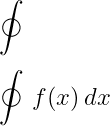Closed integrals are represented by adding circles to the integral symbols, without specifying upper limits. LaTeX offers multiple commands to denote this symbol.
If you ever need to use a closed integral symbol in your document, it’s super easy! You’ll just need to include an external package to get the right formatting.
The default LaTeX setup doesn’t have this symbol built-in, but by using the right package, you can display it perfectly without any hassle.
Use esint package for close integral symbol
To represent closed integral symbols, you can simply use the \oint command, especially when you’re working with the esint package.
\documentclass{article}
\usepackage{esint}
\begin{document}
\[ \oint \]
\[ \oint\, f(x)\, dx \]
\end{document}Output :
You probably know about the surface closed integral. Mathematically, the closed double integral symbol represents the surface closed integral.
In this case, you can use both the \oiint and \varoiint commands.
\documentclass{article}
\usepackage{esint}
\begin{document}
\[ \varoiint_{s} f(x,y)dxdy \]
\[ \oiint_{s} f(y,z)dydz \]
\end{document}Output :
The \varoiint command represents an integral symbol over a closed surface.
Use wasysym package for close integral symbols
The \oint and \oiint commands in the wasysym package represent closed line and surface integrals without needing the esint package.
\documentclass{article}
\usepackage{wasysym}
\begin{document}
\[ \oint_{\theta}F(\theta)d{\theta} \]
\[ \oiint_{s}F(x,z)dxdz \]
\end{document}Output :
Summary
Using closed integrals in LaTeX is straightforward if you use the right packages. The esint package offers commands such as \oint, \oiint, and \varoiint for representing closed integrals.
Additionally, the wasysym package provides similar symbols. Both packages make it easy to create professional and polished integral symbols in your LaTeX document.


